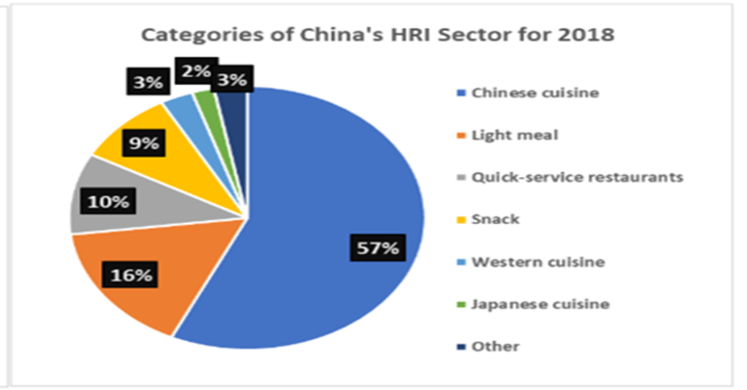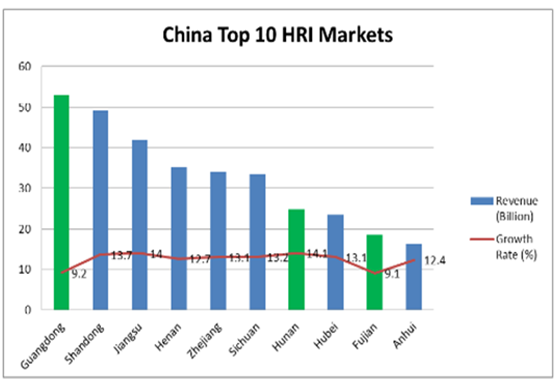China’s Hotel, Restaurant, and Institutional* (HRI) sectors recorded $687 billion in sales revenue in 2019, a 9% increase from the previous year. With the onset of COVID-19 in December of 2019, demand patterns for HRI sales underwent significant changes with first quarter sales contracting but rebounding in the second quarter of 2020
Restaurants accounted for the largest share of the sector with approximately 37% of the HRI sector. Hotels accounted approximately for 35% and Institutional food service accounted for 28%.
China’s HRI sector is driven by many economic and cultural factors. The Hotel, Restaurant, and Institutional sector is highly fragmented and dominated by small-to-medium enterprises. Restaurants serving China’s regional cuisines (e.g., Sichuan Hot Pot, Southern Chinese dumplings, etc.) continue to be more popular – 57% of the market – than restaurants serving international cuisines (e.g., Steak houses, pizza and hamburger restaurants, etc.), especially in Tier 2 and Tier 3 cities. Light meal and quick-service restaurants are follow behind at 16% and 10% respectively.
While restaurants serving local cuisines continue to dominate the market, western cuisines are becoming popular in Tier 1 cities. Restaurants serving western cuisines account for approximately 3% of the total HRI sector revenue.

Emerging “healthy eating” Trends
In 2020 and beyond, Chinese consumer demand for safe, high quality imported products will continue to be driven by China’s rising disposable incomes and increasing urbanization. Consumers are becoming more conscious about their overall health and are paying more attention to the nutritional value of dishes and food.

Hotels and Resorts
Many internationally owned or managed hotel groups are rapidly expanding operations in second, third-tier cities and top tourism destinations. Unlike in many Western countries, restaurants in hotels are not necessarily visited by only lodging guests, but instead are frequently visited by outside guests. Generally speaking, restaurants in the hotels are considered to have superior quality and service.
European wine is popular among Chinese. Chile and Australia offer competitive pricing. The imported craft beer industry is still in the nascent stages. China’s wine industry is evolving,but it may take years to catch up with international market leaders. Local beer dominates the market.

South China Regional Profile – HRI
South China includes five provinces: Guangdong, Guangxi, Fujian, Hainan and Hunan and is one of the most vibrant HRI markets in China. Guangdong continues to take the lead in national HRI revenue, and in 2016, the province’s HRI sector reached $53 billion (10% of total national HRI revenue), a 9% increase from the previous year. In addition, Hunan ($25 billion, 14% increase) and Fujian province ($18.5 billion, 9% increase) were also top ten HRI markets in Mainland China.
While Guangzhou, Shenzhen, Xiamen and Changsha are the four most well-known cities for foodies in South China, consumer preferences in these cities are quite different. Cantonese food, together with different regional cuisines, is very popular among local residences and the migrant population in Guangzhou. In Shenzhen, however, the consumer base is younger and from all over China, and has many young white-collar professional workers. As a result, over 50% of HRI revenue comes from quick service restaurant and fast food. Changsha consumers are more inclined to have local Hunan cuisine, and consumers would prefer having milk tea and fresh fruits during snack time. Consumers in Xiamen are fond of Western cuisines and café.
Key Points
- South China is one of the most vibrant HRI market in China
- Chinese consumer demand for safe, high quality imported products
- Restaurants accounts with 37% of the HRI sector
- Highly fragmented and dominated by small-to-medium enterprises
- Restaurants serving western cuisines account for approx. 3% of the total HRI sector revenue
- Hotels accounts with 35% of the HRI sector
- Restaurants in hotels are frequently visited by outside guests.